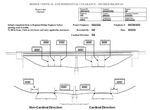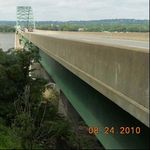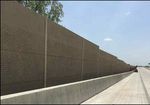WISCONSIN DOT STRUCTURES INSPECTION PROGRAM TECHNICAL BULLETIN Issue 6 - Winter 2020
←
→
Page content transcription
If your browser does not render page correctly, please read the page content below
WISCONSIN DOT
STRUCTURES INSPECTION PROGRAM
TECHNICAL BULLETIN
Issue 6 – Winter 2020
LOAD POSTING FOR EMERGENCY VEHICLES
This fall, Wisconsin DOT has been placing new Emergency Vehicle Weight Limit signs at several bridges on or near the
Interstate. This is a result of the 2015 FAST Act, federal legislation that allows emergency vehicles to exceed standard
highway weight limits. It also requires states to evaluate bridges specifically for firetruck loads and to notify operators of
weight limits, if necessary. Emergency vehicle posting have no bearing on commercial or OSOW vehicles. Please click
HERE for additional details and the location of the affected bridges.
Bureau of Traffic Operations and Bureau of Structures are working together for initial sign installation and
documentation. BOS has been in contact with local fire departments to discuss these signs. For bridges with Emergency
Vehicle Weight Limits, bridge inspectors need to be aware of the
following:
Assessment 9034 (Weight Limit Posting Signs) shall be included,
just as with standard weight limit postings.
If not already on file at time of next inspection, a Load Posting
Verification Form (DT2122) shall be completed and uploaded
into the Highway Structures Information System (HSIS).
Emergency Vehicle posting signs are only required at the bridge,
without advanced warning signs.
Emergency Vehicle postings are excluded from the annual
inspection requirement for posted bridges, unless otherwise
required based on condition.
Bureau of Structures will be evaluating all bridges throughout
the state for emergency vehicle loads over the next two years,
however posting signs are only required on bridges on the
Interstate and within one-mile access. Other bridges will be
placed on a list distributed to fire departments.
For questions on Emergency Vehicle postings, please contact Alex Pence at alex.pence@dot.wi.gov.
STATE BRIDGE DECK SCANNING POLICY
An inspection memo and guidance in Part I of the SIM will be published by the end of the year concerning state-owned
structures to describe criteria for non-destructive testing (NDT) on bridge decks. Most of the criteria contained in this
memo will be used for managing the bridge deck survey master contracts. Central office will continue to coordinate with
regional Inspection Program Managers and other state inspectors to write contracts to perform most NDT. Results from
these NDT methods will be entered as Deck Evaluation inspection activities in HSIS. These Deck Evaluations may
recommend quantities of defect condition states in the next inspection. The inspector should review the latest Deck
Evaluation to determine the actual quantities to record in the inspection. The inspector may also perform chaining on
100% of the wearing surface during the routine inspection. The results of this chaining can be entered as a Deck
Evaluation activity within the Routine inspection.FRACTURE CRITICAL MEMBERS (FCM’S) POLICY The 2019 FHWA 23 metric review revealed some deficiencies in the FCM’s policy. WisDOT reviewed recommendations and have clarified the following two items in the Fracture Critical Policy: First, FHWA requested a note to be provided on FCM diagrams that primary gusset plates connect to FCM’s are considered fracture critical. This is in addition to stating it in the inspection procedures, see example shown. BOS has updated all applicable FCM diagrams to include this statement. The second clarification involves floor beams. In October 2020, the language was updated and guides the inspector to treat all floor beams spaced greater than 14 feet apart as if they are fracture critical, even though they will not be classified as such. What this means is that all floor beams meeting the criteria shall have an arms-length inspection for the entire tension portion of the floor beam, including the floor beam connection(s) to the primary load carrying member. These floor beams will be inspected using the same techniques as FCM’s. The floor beams shall be inspected at the fracture critical inspection frequency for the bridge in question and be inspected by a certified fracture critical inspector. In rare cases where arms-length access cannot be safely accomplished by traditional methods (reach-all, ladder, etc.), alternative means of inspection are necessary. These methods require detailed inspection procedures that must be approved by BOS prior to use. Please coordinate with BOS Maintenance prior to developing these procedures. This Policy can be found on our website under Policy Memos and Part 1 Chapter 3 of the Structures Inspection Manual (SIM). 2019 LOCAL INSPECTION EXTENDED FREQUENCIES Recently, Wisconsin requested permission from the Federal Highway Administration (FHWA) to implement extended bridge inspection frequencies for lower risk structures. Included in that request were distinct criteria for bridges to qualify for extended Routine and Underwater Dive intervals. On November 5, 2019 FHWA formally approved that request. Subsequently, WisDOT developed an implementation plan for 2020 to include State owned structures as a pilot project and targeted 2021 as the year that local agencies would be eligible to utilize these policies. To utilize these policies (it is not a requirement), a new version of the DT2002 Structure Inspection Quality Control Form will need to be submitted by the County PM or Commissioner and can be found at this website. This form details specific information relevant to a successful inspection program and allows the local agency to ‘Opt-in’ to using extended frequencies for qualifying structures. The deadline for applying for the 2021 inspection season is February 1st, 2021. This Policy can be found on our website under Policy Memos and Part 1 chapter 3 of the SIM. INSPECTION REMINDERS Structure Review Process - Bureau of Structures Structural Review Process Guide is posted on the Maintenance & Inspection website. This is a flow chart to outline the expectations and necessary steps for completing an Inspection Action. Inspection Actions are required when element deterioration has reached Condition State 4 or the quantity in CS4 increases. The Structural Review Policy Memo, also on the website, defines cases, responsibility and timelines for completing the structural review. In some cases, HSIS will automatically require an Inspection Action and in other cases, the inspector is responsible for manually adding it. Inspection Actions are most often Structural Reviews completed by a professional engineer, but they can also be completed by performing repairs or following the Critical Finding process.
Official Bridge Files - Official bridge files should be prepared and stored per the SIM 1.2.4 Official Structure Files.
Paper copies are not required to comply with the FHWA Metrics since the official signed reports are stored in HSIS, but
counties may request paper copies for their own records.
Vertical Under Clearance - The vertical under clearance is measured during inspections of bridge and sign structures
that span over traffic (usually vehicular, but this could be ship traffic as well). The inspector should check the “Vertical
Clearance Measured” activity in HSIS and include a document showing where the clearances were measured. Clearance
measurements should be taken if there has been construction affecting the structure. For signs or signal structures
measurements are required with every inspection due to the frequency that the sign/signal panels are replaced. Some
examples are shown for reference.
Maintenance Items - Inspectors are to place applicable maintenance recommendations within the inspection report to
correct deficient elements and to arrest further deterioration of the element. It is important to include in the maintenance
recommendations an appropriate estimate of when the work should be completed. This helps maintenance coordinators
select the appropriate maintenance items needed thereby extending the life of the bridge. Please refrain from using a
High Priority for items that do not require action to be within 30 days. The priorities are defined as follows:
High Priority - To be completed within 30 days of the finding.
Medium Priority - To be completed within a year of the finding.
Low Priority - To be completed before the next inspection.
More information on maintenance items can be found in the 2020 WisDOT Structure Inspection Field Manual on page 14.
Inspectors are encouraged to provide additional pictures in inspection reports that help show overall condition of the
structure. It is also good practice to take photos of maintenance items needed and can now be uploaded in HSI under the
maintenance tab for each item. Below is what it looks like in a completed report. These photos help maintenance
coordinators see the extent of problems and serve to help future inspectors to determine if work was done.INITIAL SIGN/HML INSPECTIONS
As part of the Wind Loaded Structures Initiative, the
B -40-400 Standard Specifications were updated to include the initial
inspection of overhead sign and high mast light structures.
Language for this change can be found in ASP-6. The initial
inspection will be completed per the SIM for overhead signs
and HML structures but will now be the responsibility of the
contractor for state LET construction projects. BOS will
B -55-224 B -22-60
continue to maintain master contracts for sign, signal and
HML inspections for routine and quality assurance
inspections for state structures.
p -40-847
Random Fact: Below is a list of the longest STRUCTURES INSPECTION TRAINING
structures in Wisconsin.
2019 WisDOT Structure Inspection Refresher Training,
Category Structure # Length
see Attachement A of May 2019 Bulletin for complete
Bridge (w/units) B-40-400- 27,347 ft
directions. This training is required for all inspectors that
Bridge (w/o units) B-55-224 5,079 ft
670 ft want to remain active team leaders and all new inspectors
Bridge (single span) B-22-60
No Plan Bridge P-40-847 3,415 ft coming into the program. Inspectors can take the training
C-Structure C-40-38* 3,410 ft modules multiple times if they wish.
Retaining Wall R-40-540 3,085 ft NHI Course 130056 - Safety Inspection of In-Service
Noise Wall N-05-10-1 6,304 ft Bridges for Professional Engineers
Sign S-05-168 205 ft o Course has been tentatively postponed to Fall of 2021.
Signal S-18-52 138 ft Ancillary Structures Bolt & Anchor Rod Training
High Mast Light Tie L-40/L-67 150 ft o The Bureau of Structures posted a 2-part ancillary
*Part of STH145 Storm Sewer, connects to SS to the north and MMSD structures bolt and anchor rod training module that will
SS to the South. To get to structure, add an additional 2,000± ft be added to the Structures Inspection Refresher Training
through MMSD SS box culvert which outlets at Lincoln Cr.
currently on the Learn Center. This online training is
intended to replace the previous 1-day bolting course
and covers WisDOT specific requirements and
procedures for bolt and anchor rod tensioning. These
modules will be required refresher training for all
Ancillary Sign/ Signal/HML inspection team leads and
C -40-38 R -40-540 recommended for team members, who will need to
submit the completion certificate by December 31, 2020.
S -5-168 The modules will also be required for contractors who build
L -40\67 “S” Sign and “L” High Mast Lighting structures and highly
recommended for region and consultant construction staff.
Please contact Steve Doocy, Steve.Doocy@dot.wi.gov, if you
N -5-10-1 S 18-52
have any questions.
ABOUT THE BULLETIN
The Bureau of Structures at WisDOT will publish 1~2 newsletters a year to discuss topics involving inspection,
maintenance, repair, or improvement information and initiatives. If you have ideas for future topics, please submit to
Rick Marz, Travis McDaniel, Matt Coupar or Steve Doocy.INSPECTION PROGRAM CONTACTS
Office Name Phone Cell Email Role
608-609-
FHWA Joe Balice 608-829-7528 joe.balice@dot.gov FHWA Bridge Engineer
5025
Bureau of Structures Richard Marz 608-266-8195 608-516-6376 richard.marz@dot.wi.gov Statewide Inspection Program Manager
Bureau of Structures Travis McDaniel 608-266-5097 travis.mcdaniel@dot.wi.gov Assistant Statewide Inspection Program Manager
Bureau of Structures Matt Coupar 608-266-5083 Matthew.Coupar@dot.wi.gov Statewide Bridge Inspection Program Manager
Bureau of Structures Steve Doocy 608-261-6063 Steve.doocy@dot.wi.gov Statewide Ancillary Inspection Program Manager
Bureau of Structures James Kast 608-516-6370 james.kast@dot.wi.gov Reach-All Operator & Inspection/Maintenance
Bureau of Structures Mark Dent 608-516-6374 mark.dent@dot.wi.gov Reach-All Operator & Inspection/Maintenance
Bureau of Structures Craig Hampton 608-516-6373 craig.hampton@dot.wi.gov Reach-All Operator & Inspection (Scheduling)
Bureau of Structures Matt Tourdot Mathew.tourdot@dot.wi.gov Reach-All Operator & Inspection/Maintenance
Bureau of Structures Nate Sippel Nathaniel.Sippel@dot.wi.gov Reach-All Operator & Inspection/Maintenance
Bureau of Structures Dean Strey dean.strey@dot.wi.gov Reach-All Operator & Inspection/Maintenance
Bureau of Structures Ryan Bowers 608-267-3577 Ryan.bowers@dot.wi.gov Bridge Management Engineer / HSI Contact
Waukesha (SE) Scott Reay 262-548-6715 414-750-1504 Scott.reay@dot.wi.gov (acting) SE Region Bridge Inspection Program Manager
Madison (SW) Michael Williams 608-516-6484 608-246-3250 michael.williams@dot.wi.gov SW Region Bridge Inspection Program Manager
Madison (SW) Steven Katzner 608-516-6425 steven.katzner@dot.wi.gov SW Region Bridge Inspection Program Manager
La Crosse (SW) David Bohnsack 608-785-9781 608-792-6084 david.bohnsack@dot.wi.gov SW Region Bridge Inspection Program Manager
Green Bay (NE) Dale Weber 920-492-7161 920-366-6430 dale.weber@dot.wi.gov NE Region Bridge Inspection Program Manager
Wisconsin Rapids (NC) Tom Hardinger 715-421-8323 715-459-4269 thomas.hardinger@dot.wi.gov NC Region Bridge Inspection Program Manager
Rhinelander (NC) Brock Gehrig 715-365-5799 715-493-4397 brock.gehrig@dot.wi.gov NC Region Bridge Inspection Program Manager
Superior (NW) Gregory Haig 715-577-0646 gregory.haig@dot.wi.gov (acting) NW Region Bridge Inspection Program Manager
Eau Claire (NW) Gregory Haig 715-577-0646 gregory.haig@dot.wi.gov NW Region Bridge Inspection Program Manager
To make an appointment to visit our socially distanced office, please call ahead. When calling to set up an appointment,
please be patient, our internet connection and availability is subject to livestock and high water.
This “office” was found in a cattle pass structure in Lafayette County, complete with
working phone, desk and chair. The plywood makes for a wind block. Not a bad way to
stay socially distant.You can also read



























































